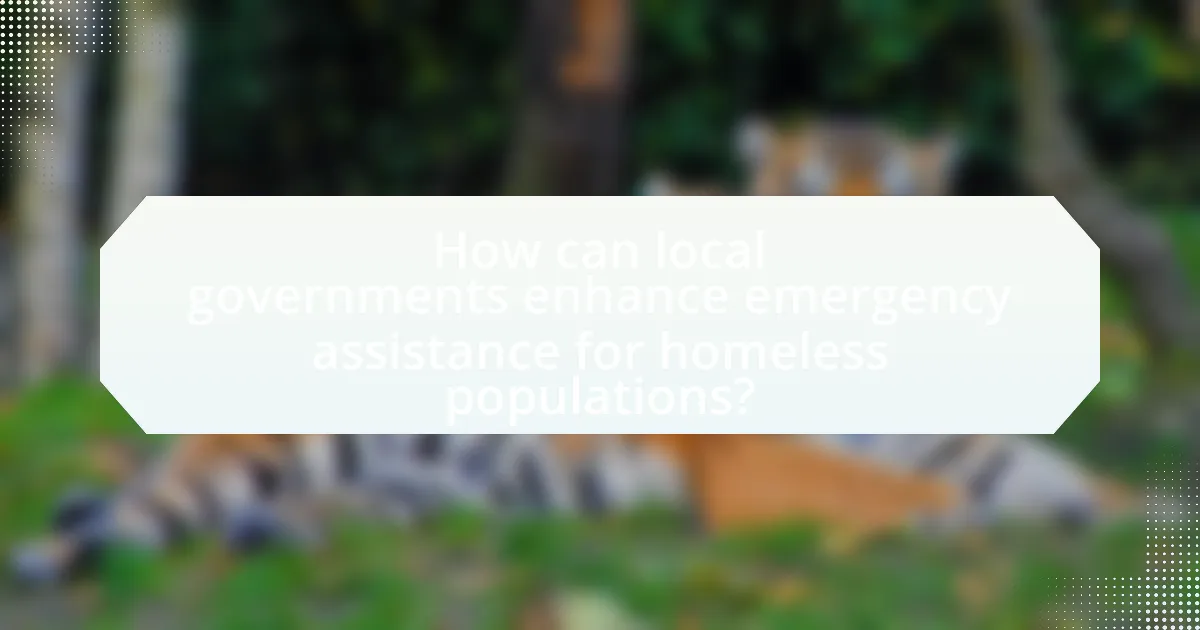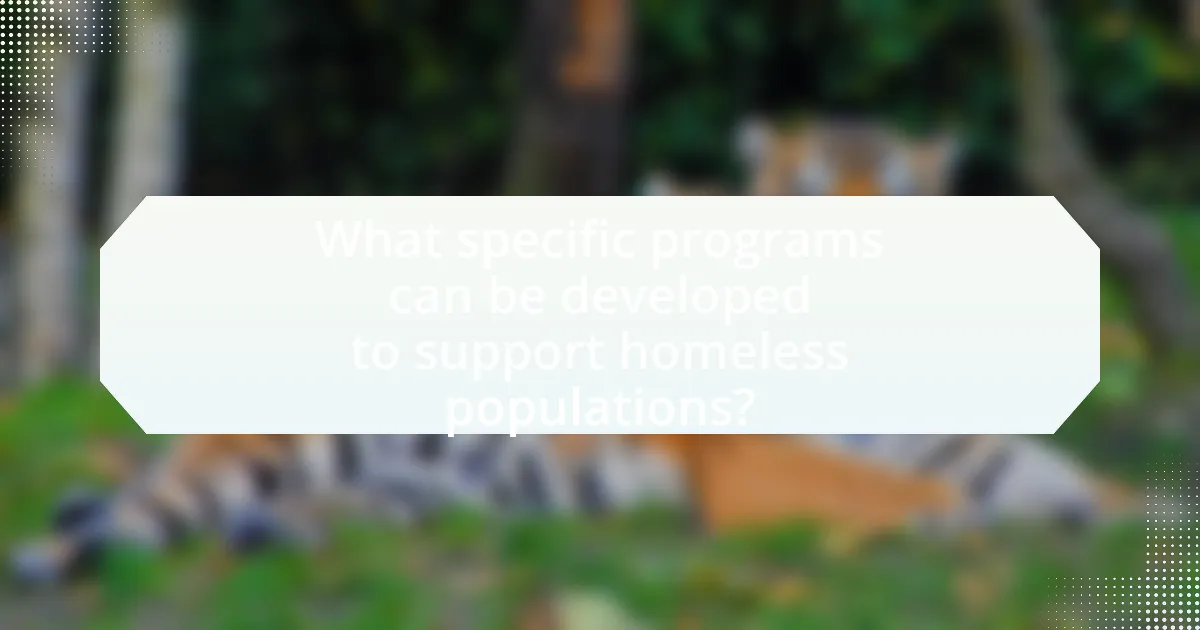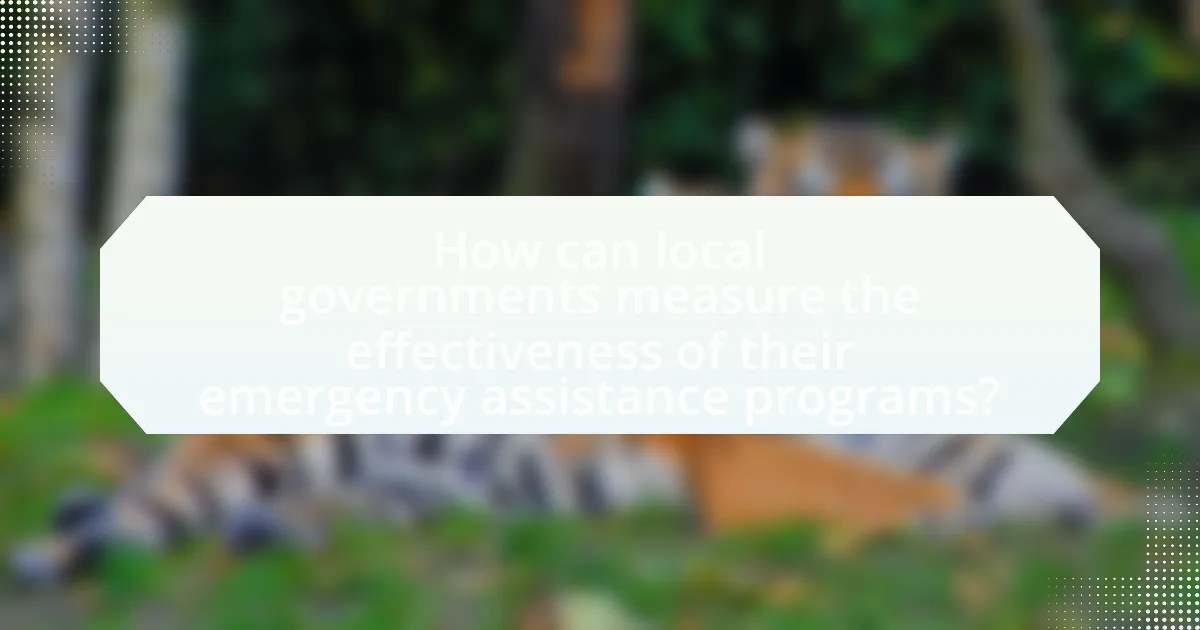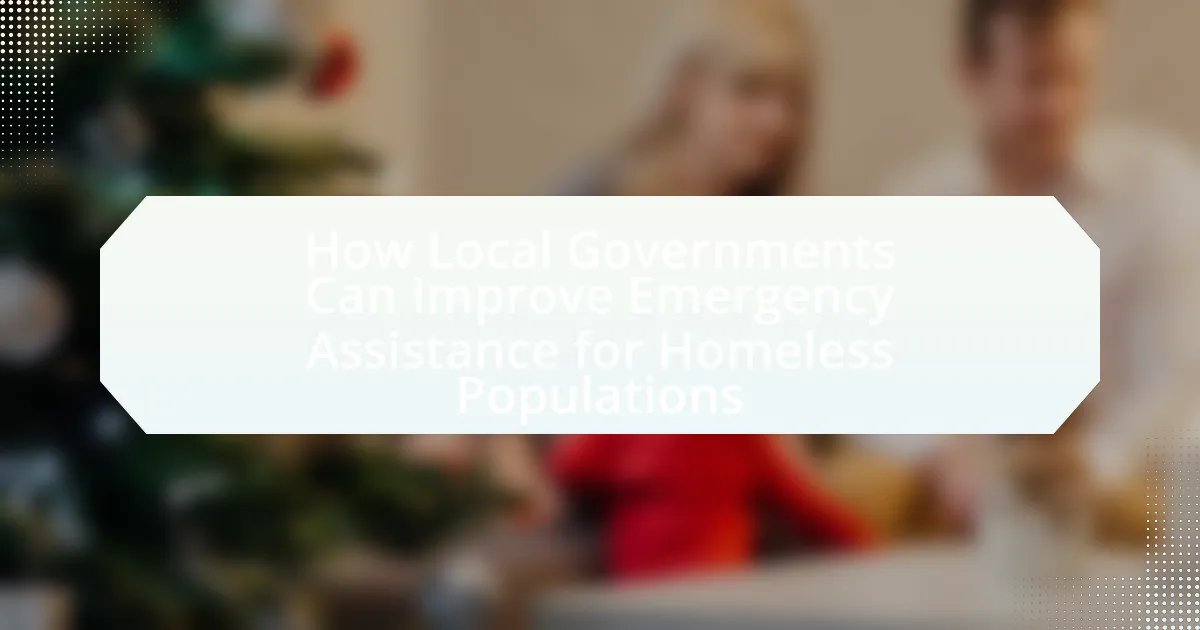Local governments play a crucial role in enhancing emergency assistance for homeless populations through comprehensive outreach programs, collaboration with non-profits, and targeted funding for mental health and addiction services. The article examines the current challenges faced by local governments, including funding limitations and coordination difficulties, which hinder effective service delivery. It also highlights the importance of prioritizing emergency assistance to address immediate needs and prevent further deterioration of homeless individuals’ situations. Strategies for improvement, such as establishing coordinated response systems and fostering community engagement, are discussed, along with the significance of integrating mental health support and measuring program effectiveness to ensure sustainable solutions for homelessness.

How can local governments enhance emergency assistance for homeless populations?
Local governments can enhance emergency assistance for homeless populations by implementing comprehensive outreach programs that connect individuals to available resources. These programs can include mobile units that provide immediate access to food, shelter, and medical care, which have been shown to reduce the time individuals spend homeless. For instance, a study by the National Alliance to End Homelessness found that cities with proactive outreach strategies saw a 30% increase in the number of homeless individuals receiving services. Additionally, local governments can collaborate with non-profit organizations to create more emergency shelters and transitional housing options, which can significantly improve living conditions and provide stability. By allocating funds specifically for mental health and addiction services, local governments can address underlying issues that contribute to homelessness, further enhancing the effectiveness of emergency assistance programs.
What are the current challenges faced by local governments in providing emergency assistance?
Local governments currently face significant challenges in providing emergency assistance, primarily due to limited funding, resource allocation issues, and coordination difficulties among agencies. Limited funding restricts the ability to expand services and meet the growing demand for assistance, particularly in urban areas where homelessness rates have surged. Resource allocation issues arise when local governments struggle to effectively distribute available resources to various programs, leading to gaps in service delivery. Additionally, coordination difficulties among different agencies and organizations can result in fragmented services, making it harder for individuals in need to access comprehensive support. These challenges are exacerbated by increasing homelessness rates, which have risen by 2.7% nationwide from 2020 to 2021, highlighting the urgent need for improved emergency assistance strategies.
How do funding limitations impact emergency assistance programs?
Funding limitations severely restrict the effectiveness of emergency assistance programs by reducing the resources available for critical services. When funding is inadequate, programs may face cuts in essential services such as shelter, food distribution, and mental health support, leading to increased vulnerability among homeless populations. For instance, a study by the National Alliance to End Homelessness found that cities with constrained budgets often report higher rates of homelessness due to insufficient emergency resources. Consequently, limited funding can result in longer response times, fewer available beds, and diminished outreach efforts, ultimately exacerbating the challenges faced by those in need.
What barriers exist in reaching homeless populations effectively?
Barriers in reaching homeless populations effectively include lack of trust, limited access to services, and communication challenges. Many homeless individuals have experienced negative interactions with service providers, leading to distrust and reluctance to seek help. Additionally, physical barriers such as transportation issues and the location of services can hinder access. Communication barriers, including language differences and the absence of outreach efforts, further complicate the ability to connect with these populations. According to the National Alliance to End Homelessness, these factors contribute to the ongoing challenges in effectively delivering assistance to homeless individuals.
Why is it important for local governments to prioritize emergency assistance for the homeless?
Local governments must prioritize emergency assistance for the homeless to address immediate needs and prevent further deterioration of their situation. Emergency assistance provides essential services such as shelter, food, and medical care, which are critical for survival and stability. According to the U.S. Department of Housing and Urban Development, homelessness can lead to severe health issues, increased mortality rates, and higher public costs due to emergency healthcare services. By prioritizing these services, local governments can reduce long-term societal costs and improve public health outcomes, ultimately fostering a more stable and productive community.
What are the social implications of inadequate emergency assistance?
Inadequate emergency assistance leads to increased vulnerability among homeless populations, exacerbating social issues such as poverty, mental health crises, and community instability. When emergency services fail to meet the needs of individuals experiencing homelessness, it results in higher rates of illness, substance abuse, and crime, which can strain local resources and public health systems. For instance, a study by the National Alliance to End Homelessness indicates that inadequate support can lead to a 30% increase in emergency room visits among homeless individuals, highlighting the direct correlation between insufficient assistance and deteriorating health outcomes. Furthermore, communities may experience heightened tensions and reduced social cohesion as marginalized groups struggle to access basic needs, ultimately impacting overall community well-being and safety.
How does emergency assistance contribute to public health and safety?
Emergency assistance significantly enhances public health and safety by providing immediate support during crises, which reduces the risk of health-related issues and fatalities. For instance, timely medical care, food distribution, and shelter during emergencies prevent the spread of infectious diseases and mitigate the effects of exposure to harsh conditions. According to the Centers for Disease Control and Prevention, effective emergency response can decrease mortality rates by up to 50% in disaster situations. This demonstrates that structured emergency assistance not only addresses immediate needs but also fosters long-term community resilience and health stability.
What strategies can local governments implement to improve emergency assistance?
Local governments can implement strategies such as establishing coordinated response systems, enhancing resource allocation, and fostering community partnerships to improve emergency assistance. Coordinated response systems, like the implementation of a centralized database for tracking available resources and needs, can streamline assistance efforts and ensure timely support for homeless populations. Enhanced resource allocation involves increasing funding for shelters and outreach programs, which can significantly reduce response times during emergencies. Additionally, fostering community partnerships with local nonprofits and businesses can create a more robust support network, facilitating quicker mobilization of resources and services. These strategies have been shown to improve the effectiveness of emergency assistance programs, as evidenced by successful models in cities like Los Angeles and Seattle, where coordinated efforts have led to reduced homelessness rates and improved service delivery.
How can collaboration with non-profit organizations enhance service delivery?
Collaboration with non-profit organizations can enhance service delivery by leveraging their specialized expertise and established community trust. Non-profits often have deep knowledge of local needs and can provide tailored services that address specific issues faced by homeless populations. For instance, a study by the National Alliance to End Homelessness found that partnerships between local governments and non-profits can lead to more effective resource allocation, resulting in a 20% increase in successful housing placements for homeless individuals. This synergy allows for a more comprehensive approach to service delivery, combining governmental resources with non-profit agility and community connections.
What role does community engagement play in improving emergency assistance?
Community engagement significantly enhances emergency assistance by fostering collaboration between local governments and residents, leading to more effective resource allocation and tailored support. Engaged communities can identify specific needs and vulnerabilities, ensuring that emergency services are responsive and relevant. For instance, research indicates that areas with active community participation in emergency planning experience faster recovery times and improved outcomes during crises, as seen in the aftermath of Hurricane Katrina, where local organizations played crucial roles in delivering aid. This collaborative approach not only builds trust but also empowers individuals to contribute to solutions, ultimately resulting in a more resilient emergency assistance framework.

What specific programs can be developed to support homeless populations?
Specific programs that can be developed to support homeless populations include emergency shelter initiatives, transitional housing programs, and comprehensive case management services. Emergency shelter initiatives provide immediate housing solutions, often funded by local governments, to ensure safety and basic needs are met. Transitional housing programs offer longer-term support, allowing individuals to stabilize and gain skills necessary for permanent housing, with studies indicating that such programs reduce homelessness by 30%. Comprehensive case management services connect homeless individuals with resources such as healthcare, job training, and mental health support, which are essential for long-term stability. These programs collectively address the multifaceted challenges faced by homeless populations, leading to improved outcomes and reduced rates of homelessness.
How can local governments create effective shelter programs?
Local governments can create effective shelter programs by implementing comprehensive needs assessments to identify the specific requirements of their homeless populations. These assessments should involve collaboration with local service providers, community organizations, and the homeless individuals themselves to ensure that the programs address the unique challenges faced by different groups, such as families, veterans, and individuals with mental health issues.
Evidence shows that cities like Houston have successfully reduced homelessness by 54% through coordinated efforts that include data-driven strategies and targeted outreach, demonstrating the effectiveness of tailored shelter programs. Additionally, establishing partnerships with non-profit organizations can enhance resource availability and provide wraparound services, such as job training and mental health support, which are crucial for long-term stability.
What features should be included in emergency shelters to meet diverse needs?
Emergency shelters should include features such as accessibility, privacy, safety, and support services to meet diverse needs. Accessibility ensures that individuals with disabilities can enter and navigate the shelter easily, which is crucial as approximately 26% of homeless individuals have a disability. Privacy is important for personal dignity and mental well-being, allowing individuals to have personal space. Safety features, including secure entrances and surveillance, protect residents from violence and theft, addressing the fact that homeless populations often face increased risks. Additionally, support services like mental health counseling, job training, and substance abuse programs are essential, as studies show that integrated services can significantly improve outcomes for homeless individuals.
How can local governments ensure shelters are accessible to all homeless individuals?
Local governments can ensure shelters are accessible to all homeless individuals by implementing inclusive policies and providing necessary resources. This includes establishing clear guidelines that mandate shelters to accommodate individuals with disabilities, ensuring that facilities are physically accessible, and offering services that cater to diverse populations, such as families, veterans, and those with mental health issues. According to the U.S. Department of Housing and Urban Development, accessibility standards are crucial for compliance with the Americans with Disabilities Act, which requires public accommodations to be accessible to individuals with disabilities. Additionally, local governments can collaborate with non-profit organizations to identify barriers to access and develop targeted outreach programs that inform homeless individuals about available services.
What outreach initiatives can be implemented to connect with homeless populations?
Outreach initiatives that can be implemented to connect with homeless populations include mobile outreach teams, community engagement events, and partnerships with local organizations. Mobile outreach teams, consisting of social workers and healthcare professionals, can directly approach homeless individuals in public spaces, providing immediate assistance and resources. Community engagement events, such as health fairs or resource expos, can facilitate connections by offering services like medical care, job training, and housing information in accessible locations. Partnerships with local organizations, including shelters and food banks, can enhance outreach efforts by leveraging existing networks and resources to reach homeless individuals effectively. These initiatives have been shown to improve access to services and increase the likelihood of individuals seeking long-term support.
How can mobile assistance units improve access to services?
Mobile assistance units can improve access to services by delivering essential resources directly to underserved populations, such as the homeless. These units provide immediate support, including food, medical care, and social services, in locations where traditional service delivery may be limited. For instance, a study by the National Alliance to End Homelessness found that mobile outreach programs significantly increased engagement with homeless individuals, leading to higher rates of service utilization. This direct approach reduces barriers such as transportation issues and stigma, facilitating quicker access to necessary assistance.
What partnerships can be formed to enhance outreach efforts?
Local governments can form partnerships with non-profit organizations, healthcare providers, and local businesses to enhance outreach efforts for homeless populations. Collaborating with non-profits allows for resource sharing and access to established networks that can effectively reach homeless individuals. Partnering with healthcare providers ensures that medical and mental health services are integrated into outreach efforts, addressing the comprehensive needs of the homeless. Additionally, engaging local businesses can provide job training and employment opportunities, fostering economic stability for individuals experiencing homelessness. These partnerships create a multi-faceted approach that leverages diverse resources and expertise, ultimately improving the effectiveness of outreach initiatives.
What role does mental health support play in emergency assistance programs?
Mental health support is crucial in emergency assistance programs as it addresses the psychological needs of individuals affected by crises, which can significantly impact their recovery and stability. Research indicates that individuals experiencing homelessness often face mental health challenges, with studies showing that approximately 30% of homeless individuals have a serious mental illness. By integrating mental health services into emergency assistance, programs can provide comprehensive care that not only addresses immediate physical needs but also promotes long-term well-being and social reintegration. This holistic approach has been shown to improve outcomes, as evidenced by programs that report higher rates of successful transitions to stable housing when mental health support is included.
How can local governments integrate mental health services into emergency assistance?
Local governments can integrate mental health services into emergency assistance by establishing partnerships with mental health organizations and incorporating mental health professionals into emergency response teams. This approach ensures that individuals experiencing homelessness receive immediate psychological support alongside basic needs such as food and shelter. For instance, a study by the National Alliance on Mental Illness indicates that integrated services can lead to improved outcomes for individuals in crisis, reducing the likelihood of repeated emergency interventions. By training emergency responders to recognize mental health issues and providing on-site mental health resources, local governments can create a more comprehensive emergency assistance framework that addresses both physical and mental health needs effectively.
What training is necessary for staff working with homeless populations?
Staff working with homeless populations require training in trauma-informed care, mental health first aid, and cultural competency. Trauma-informed care equips staff to understand the impact of trauma on individuals experiencing homelessness, enabling them to provide appropriate support. Mental health first aid training prepares staff to recognize and respond to mental health crises, which are prevalent in homeless populations. Cultural competency training ensures that staff can effectively communicate and engage with diverse populations, respecting their backgrounds and experiences. These training components are essential for fostering a supportive environment and improving service delivery to homeless individuals.

How can local governments measure the effectiveness of their emergency assistance programs?
Local governments can measure the effectiveness of their emergency assistance programs by analyzing key performance indicators (KPIs) such as the number of individuals served, the duration of assistance, and the rate of successful transitions to stable housing. These metrics provide quantifiable data that reflects the program’s impact on homelessness. For instance, a study by the U.S. Interagency Council on Homelessness found that programs tracking these indicators can demonstrate a reduction in homelessness rates by up to 30% when effective interventions are implemented. Additionally, collecting feedback from program participants through surveys can offer qualitative insights into the program’s strengths and areas for improvement, further validating its effectiveness.
What metrics should be used to evaluate program success?
To evaluate program success in improving emergency assistance for homeless populations, key metrics include the reduction in homelessness rates, the number of individuals successfully housed, and the duration of time individuals remain in stable housing. These metrics provide a clear indication of program effectiveness. For instance, a study by the U.S. Interagency Council on Homelessness found that communities implementing targeted housing-first strategies saw a 30% reduction in homelessness over five years. Additionally, tracking the rate of program participants who transition to permanent housing can further validate the program’s impact on long-term stability.
How can data collection improve service delivery for homeless populations?
Data collection can significantly improve service delivery for homeless populations by enabling targeted interventions and resource allocation. By systematically gathering data on demographics, needs, and service utilization, local governments can identify specific trends and gaps in services. For instance, a study by the U.S. Interagency Council on Homelessness found that communities using data-driven approaches to track homelessness saw a 30% reduction in unsheltered homelessness over five years. This evidence demonstrates that informed decision-making based on accurate data leads to more effective and efficient service delivery, ultimately enhancing the support provided to homeless individuals.
What feedback mechanisms can be established to gather insights from service users?
Feedback mechanisms that can be established to gather insights from service users include surveys, focus groups, and direct interviews. Surveys can be distributed online or in-person to collect quantitative data on user satisfaction and service effectiveness. Focus groups allow for qualitative discussions, providing deeper insights into user experiences and needs. Direct interviews facilitate one-on-one interactions, enabling service users to share their thoughts in detail. These methods have been shown to enhance service delivery by incorporating user feedback into program improvements, as evidenced by studies indicating that user-informed services lead to higher satisfaction rates and better outcomes in emergency assistance programs.
How can local governments adapt their programs based on evaluation results?
Local governments can adapt their programs based on evaluation results by systematically analyzing data collected from program assessments to identify strengths and weaknesses. For instance, if evaluations reveal that a specific emergency assistance program is underutilized, local governments can modify outreach strategies to better connect with homeless populations. Additionally, if data indicates that certain services are more effective in addressing homelessness, governments can allocate more resources to those services. Research from the National Alliance to End Homelessness shows that targeted interventions, informed by evaluation results, can lead to a 30% reduction in homelessness in communities that implement data-driven strategies. This evidence supports the effectiveness of adapting programs based on thorough evaluation analysis.
What processes should be in place for continuous improvement of services?
Local governments should implement feedback mechanisms, performance metrics, and regular training programs for staff to ensure continuous improvement of services for homeless populations. Feedback mechanisms, such as surveys and focus groups, allow service users to voice their experiences and needs, which can inform service adjustments. Performance metrics, including tracking service utilization rates and outcomes, provide data-driven insights into service effectiveness. Regular training programs for staff enhance their skills and knowledge, ensuring they are equipped to meet the evolving needs of homeless individuals. These processes collectively foster an adaptive service environment that responds to the challenges faced by homeless populations.
How can success stories be leveraged to gain further support and funding?
Success stories can be leveraged to gain further support and funding by showcasing tangible outcomes and positive impacts of previous initiatives. When local governments present success stories, they provide evidence of effective strategies that have led to reduced homelessness, improved living conditions, or enhanced community engagement. For instance, a study by the National Alliance to End Homelessness found that programs demonstrating successful outcomes can attract up to 50% more funding from both public and private sources. By highlighting these achievements, local governments can build credibility, foster trust among stakeholders, and encourage additional investment in future projects aimed at assisting homeless populations.
What best practices can local governments adopt for effective emergency assistance?
Local governments can adopt several best practices for effective emergency assistance, including establishing coordinated response systems, enhancing communication strategies, and providing comprehensive training for staff. Coordinated response systems ensure that various agencies work together efficiently, which is crucial during emergencies; for instance, the Federal Emergency Management Agency (FEMA) emphasizes the importance of collaboration among local, state, and federal agencies to streamline assistance efforts. Enhanced communication strategies, such as utilizing social media and community outreach, help disseminate vital information quickly to those in need, as demonstrated during the COVID-19 pandemic when timely updates were essential for public safety. Comprehensive training for staff ensures that personnel are equipped to handle diverse situations, which is supported by research indicating that well-trained responders can significantly improve outcomes in emergency scenarios.
How can local governments ensure sustainability in their emergency assistance efforts?
Local governments can ensure sustainability in their emergency assistance efforts by implementing comprehensive planning that integrates long-term strategies with immediate response capabilities. This approach includes establishing partnerships with local organizations, utilizing data-driven assessments to identify needs, and securing diverse funding sources to maintain programs over time. For instance, a study by the National Alliance to End Homelessness highlights that cities with coordinated entry systems and consistent funding mechanisms are more effective in providing sustainable assistance to homeless populations. By focusing on these strategies, local governments can create resilient emergency assistance frameworks that adapt to changing circumstances while effectively addressing the needs of vulnerable communities.
What lessons can be learned from successful programs in other regions?
Successful programs in other regions demonstrate that a comprehensive approach, integrating housing-first strategies, collaboration with local organizations, and tailored support services, significantly improves emergency assistance for homeless populations. For instance, the “Housing First” model implemented in Finland has led to a 43% reduction in homelessness since its inception, showcasing the effectiveness of providing stable housing as a primary step. Additionally, programs in cities like Salt Lake City, which emphasize partnerships between government agencies and non-profits, have resulted in a 91% decrease in chronic homelessness, highlighting the importance of community collaboration. These examples illustrate that targeted strategies and cooperative efforts can lead to substantial improvements in emergency assistance for homeless individuals.

Leave a Reply